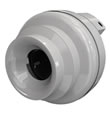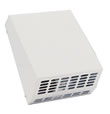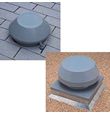|
||||||
|
This series is the most commonly used for the following reasons: - multiple fans ranging from 122 to 650 nominal CFM (see notes below on actual fan flow rates) - great performance to price ratio - available in convenient, economical kit form including grilles, "Y" fittings, etc. - fully speed controllable - 5 year warranty The next most popular fan is the RVF series. This fan mounts on an outside wall.
We would suggest this fan for: - venting first floor baths in 2 story houses - houses where the attic is otherwise inaccessible There are 5 fans ranging from 124 to 435 CFM in this series and all are fully speed controllable. For roof mounted fans, use the RE series from Fantech. This fan is designed for installation either on shingles (RE) or on flat roofs (REC) with the use of a curb.
There are multiple fans to choose from ranging from 125 to 1080 CFM and all are fully speed controllable. The last type is the CVS series from Fantech. It is basically a "fan in a box" with 3 to 4 ports on the side. This fan is great for tight spots and/or when multiple venting points are required.
There are 3 fans to choose from ranging from 250 to 405 CFM and all are fully speed controllable. Once you have selected the fan type and decided on an approximate layout for the ducting, you can use our bathroom system builder/calculator to get the actual airflow for your own system. Without getting too technical, the nominal airflow for the fan is the amount of air the fan will blow without any duct attached. Of course, adding duct, elbows, grilles, roof caps, etc. will all act to restrict the flow. Most applications will have between 0.2 and 0.4 inches of water column resistance. You can look this value up in the performance table that is shown for every fan. This will give you the actual CFM that you can expect from your fan, not just a nominal CFM. Additional Notes and Tips: - suggested maximum airflow for Fantech exhaust grills is: 4" - 100CFM, 5" - 125 CFM, 6" - 150 CFM, 8" - 200 CFM - use flexible insulating ducting to limit noise and condensation - use 8 feet or more of the insulated ductwork between the grille and the fan to maximize acustical benefits - make sure that you hang the duct so that no valleys are created -- condensation can pool in the valleys, potentially blocking the air flow - always use a backdraft damper to prevent drafts More Links: - Fantech Speed Controls and Timers - Fantech Grilles - Fantech Flexible Insulated Duct - All Fantech Products As always, if you would like to ask more questions about this or other technical topics give us a call at 877-711-4822 - 9-5 PST. Live people for technical and sales support - an Internet first! Pictures and images courtesy of Fantech. |
HVACQuick.com
high performance ventilation & green products - large in-stock inventory!
- team@hvacquick.com
- 888-855-7229





